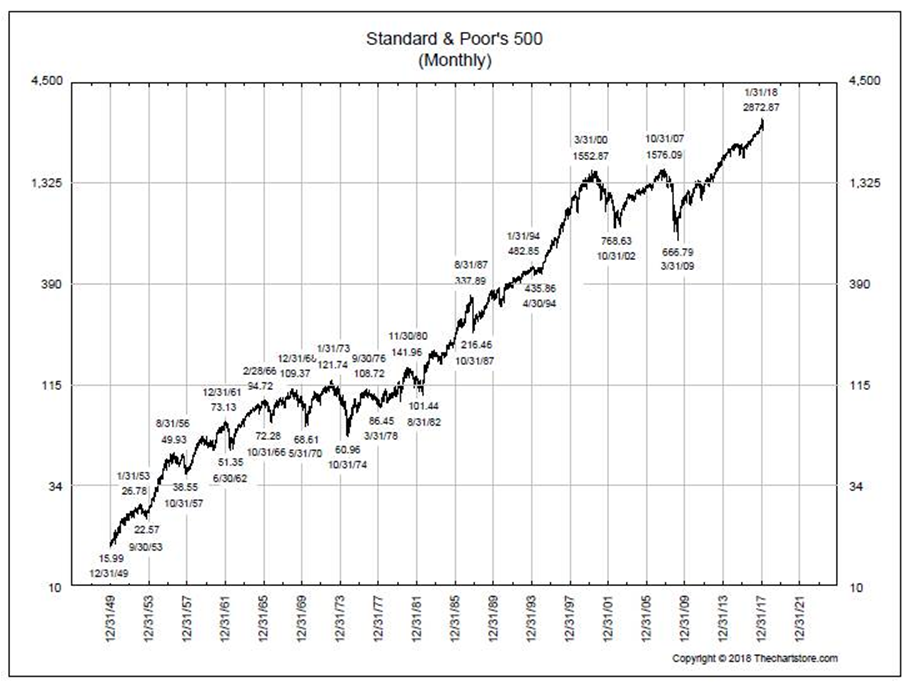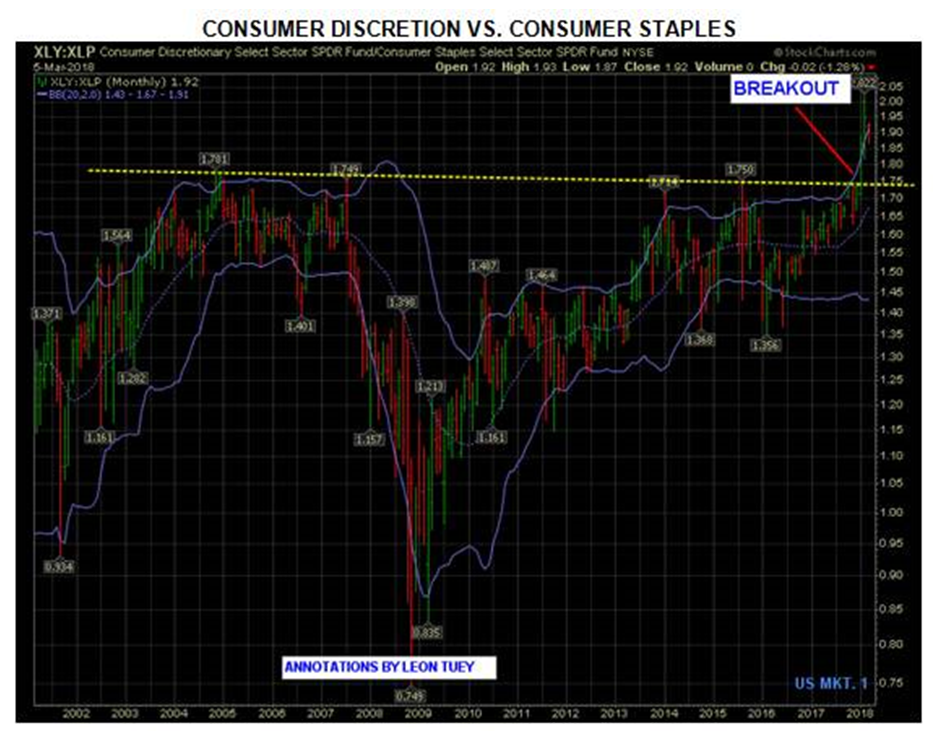by Jeffrey Saut, Chief Investment Strategist, Raymond James
“In secular bull markets most of the surprises come on the upside.”
. . . An old stock market axiom
At Raymond James we offer something called a BIO visit. The acronym BIO stands for “by invitation only.” It means that clients can come to our campus in Saint Petersburg and spend a day or two meeting with senior management of this firm, select analysts, portfolio managers, investment bankers, financial planners, me . . . well you get the idea. Over the past few weeks we have done a number of these BIO visits and the ongoing question from the clients has been, “What do you mean when you say ‘secular’ bull market?” It is a valid question because most folks believe a 20% rally, or a 20% decline, represent bull and bear markets. However, that is not what a secular bull market is. Secular bull markets last 14+ years and tend to compound money at a double-digit return per year. The secular bull market of 1949 to 1966 compounded money at 11.41% per years basis the S&P 500. The 1982 to 2000 secular bull market compounded money at 14.38% using a 20-year rolling return (Chart 1). Were there pullbacks in those secular bull markets? You bet there were, but it didn’t stop the secular bull market. And there, ladies and gentlemen, is the most misunderstood point about bull markets. Most pundits cut the 1949 – 1966 Bull Run off in 1956 when the stock market took a ~21% “hit” because Egypt attempted to take over the Suez Canal, but as can be seen in Chart 2 that did not stop the bull market. Fast forward to the 1982 – 2000 secular bull market, which many participants cut off in 1987 due to the crash, but hereto that did not stop the bull market (Chart 2). We think the current secular bull market is going to be bigger than both of those secular bull markets.
It has been said that an investor will experience three secular bull markets in their life time. In the first one you will not have enough money to take advantage of it. In the third one you will be too old to take the amount of risk to really take advantage of it. Therefore, you had better take full advantage of the second bull market. Most baby boomers were not old enough to do anything with the 1949 – 1966 “run.” Moreover, most boomers did not have enough money to take full advantage of the 1982 – 2000 rally, except near the end of that Bull Run. And then most did not heed the Dow Theory “sell signal” that occurred on September 23, 1999, so they gave back much of their late-cycle gains. Consequently, they need to take full advantage of this secular bull market, which we continue to believe has years left to run. And there is yet another much misunderstood point.
Most believe this bull market began on March 9, 2009. However, the majority of stocks made their “lows” on October 10, 2008. At the time we wrote that 92.6% of all stocks traded made new annual lows. Sure, the indices went lower into March 2009, but the majority of stocks bottomed in October 2008. That is where we think the current secular bull market began. The bottoming sequence was almost classic. We made the “selling climax” low on October 10, 2008 followed by a “throwback rally,” that failed, leading to the undercut low of March 6, 2009, which was below those October 2008 selling-climax lows. As an aside, this was the same bottoming chart pattern that we identified in February 2018 when we said to buy the “undercut low” that occurred on February 9, but we digress. Such bull markets also tend to have three upside “legs” to them. We believe the first leg began in October 2008 and ended in May 2015. The second leg began in February of 2016. The second leg is ALWAYS the longest and strongest. Once the second leg ends we should experience another upside consolidation like the one between May of 2015 and February 2016. Eventually the indices should resolve out of that consolidation on the upside and begin the third, or speculative, leg of the secular bull market. For example, the third leg of the 1982 – 2000 “run” started in late 1994 and lasted until the spring of 2000. Regrettably, there are not many of us still around that have seen a secular bull market, which is why so many refuse to trust this one. One savvy seer, however, that has seen such Bull Runs is our friend Leon Tuey, who is one of the best technical analysts on Wall Street. Recently (March 6, 2018) Leon wrote a report titled “Endless Worries.” To wit:
One of the key features of this great bull market is investor sentiment. October 10, 2018 will be the 10th anniversary of this great bull market. Yet, from its beginning to date, investors are burdened by worries, even when there is nothing to worry about. Global depression, China’s huge debt and empty cities, the European Debt Crisis, the Arab Spring, the Japanese Tsunami and nuclear plant meltdown, Capitol Hill gridlock, the U.S. election were some of the concerns that troubled investors. More recently, they worry about inflation, Fed tightening, and trade wars. They worry endlessly. Not surprisingly, the market always climbs a wall of worry.
In early February, fear was widespread and globally, investors panicked. Consequently, I concluded that peak selling intensity was witnessed and the market had entered a low-risk, high-reward juncture point and felt the after period of base-building, that the bull market would resume. Moreover, investors were advised to emphasize stock selection rather than worrying about the S&P 500. If you are worried, you are among the majority. Last Friday, the CNN Fear & Greed Index stood at 8, indicating extreme fear. Also, the Barron’s Insider Transaction Ratio dropped to 9. Readings below 12.1 are bullish. Moreover, last week, the AAII Sentiment Survey showed that the Bullish percent dropped to 37.3%. Furthermore, in the week of February 5, the ratio of VXV-to-VIX dropped to the lowest level on record. Also, it is interesting to note that in February, the TD Ameritrade Index registered its biggest monthly-drop ever; small investors bolted for the exit. Gripped by fear, investors panicked. Clearly, sentiment backdrop is ideal. Remember what Warren Buffett said – “Be fearful when others are greedy and be greedy when others fearful.”
Those who are worried about the economy, don’t fret. Take a gander at the chart [Chart 4] showing the Consumer Discretionary vs. Consumer Staples. In February, this ratio hit another record high. More importantly, it broke out of a 12-year base. The breakout suggests that in the years ahead, consumer discretionary stocks will continue to outperform Consumer Staples issues, which suggests the economy will continue to improve. Therefore, the upside breakout by this ratio has bullish implications for the economy and the stock market. Accordingly, stop worrying already!
The call for this week: The S&P 500 (SPX/2786.57) has traveled back to its February 27, 2018 intraday high of 2789.15, which was where our short-term model “said” would be a near-term top a few weeks ago. At the time the stock market’s internal energy was totally used-up and needed to be rebuilt. That is not the case currently. The market’s energy now has a full charge and both the short and intermediate-term models suggest the SPX should blow through the February 27 intraday high. If that happens there is a good chance we will break out to new all-time highs. Reinforcing that sense was this email sent to me over the weekend from Leon Tuey:
Good morning, Jeffrey. I just called your office, but I didn’t think you would be working. Many are waiting for the market to bottom or a “test” not realizing the market bottomed in early February when the whole world panicked and the great bull market had resumed. Last week, the Advance-Declines [lines] for the S&P, Dow, NDX, S&P Mid-Cap, and S&P Small-Cap closed at record highs. Clearly, recent events show that investors are still haunted by the bear market of 2007-2009. Their optimism in early January was only skin-deep as optimism turned to fear almost overnight. I’ve noticed that many of the low-price biotech and high-tech issues have traced out huge bases. What that tells me is it’s a set up for a massive speculative binge at the end of this [secular] bull market. A few years ago, I told many brokers that when this bull market ends, investors will witness the greatest upside “blow-off” on record.
Like Andrew and I have repeatedly said, “No retest of the February lows!”
Chart 1
Source: The ChartStore
Chart 2
Source: The ChartStore
Chart 3
Source: The ChartStore
Chart 4
Source: The ChartStore
Additional information is available on request. This document may not be reprinted without permission.
Raymond James & Associates may make a market in stocks mentioned in this report and may have managed/co-managed a public/follow-on offering of these shares or otherwise provided investment banking services to companies mentioned in this report in the past three years.
RJ&A or its officers, employees, or affiliates may 1) currently own shares, options, rights or warrants and/or 2) execute transactions in the securities mentioned in this report that may or may not be consistent with this report’s conclusions.
The opinions offered by Mr. Saut should be considered a part of your overall decision-making process. For more information about this report – to discuss how this outlook may affect your personal situation and/or to learn how this insight may be incorporated into your investment strategy – please contact your Raymond James Financial Advisor.
All expressions of opinion reflect the judgment of the Equity Research Department of Raymond James & Associates at this time and are subject to change. Information has been obtained from sources considered reliable, but we do not guarantee that the material presented is accurate or that it provides a complete description of the securities, markets or developments mentioned. Other Raymond James departments may have information that is not available to the Equity Research Department about companies mentioned. We may, from time to time, have a position in the securities mentioned and may execute transactions that may not be consistent with this presentation’s conclusions. We may perform investment banking or other services for, or solicit investment banking business from, any company mentioned. Investments mentioned are subject to availability and market conditions. All yields represent past performance and may not be indicative of future results. Raymond James & Associates, Raymond James Financial Services and Raymond James Ltd. are wholly-owned subsidiaries of Raymond James Financial.
International securities involve additional risks such as currency fluctuations, differing financial accounting standards, and possible political and economic instability. These risks are greater in emerging markets.
Investors should consider the investment objectives, risks, and charges and expenses of mutual funds carefully before investing. The prospectus contains this and other information about mutual funds. The prospectus is available from your financial advisor and should be read carefully before investing.


















